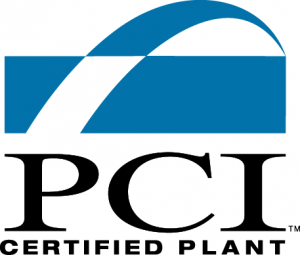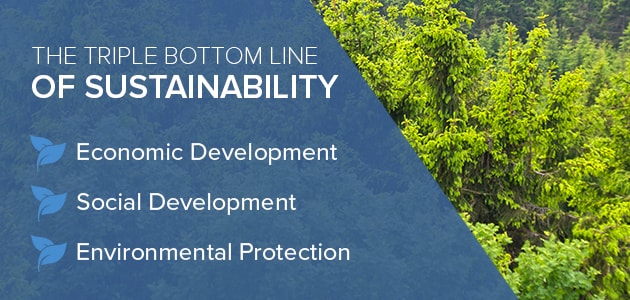
Jump-To:
- What is Sustainability?
- How Precast Concrete is Made
- Forming and Setting Precast Concrete
- Sustainability in Concrete Mix Design
- How Precast Concrete is Sustainable for the Environment
- Environmental Sustainability Benefits from Precast Concrete
- What is LEED Certification and How Does Precast Concrete Contribute?
- LEED Categories and Points
Sustainability is a watchword in today’s architectural designs and advanced construction materials. It’s often intermingled with terms like green building, energy efficiency and environmental friendliness. These current LEED (Leadership in Energy and Environmental Design) trends are immensely popular and highly encouraged for making new buildings sustainable. Many of these sustainable projects are underway across America at this moment, and they’re using sustainable architectural practices.
But sustainability doesn’t take a short-sighted view of applying the best construction techniques for today only. To be truly sustainable, buildings need a long-term vision concerning economic, environmental and social responsibilities. Developers can achieve this by using sustainable building materials and processes. One of the most popular sustainable building products is precast concrete.
Sustainable architecture refers to the environmentally conscious building movement. These designs, materials and construction techniques are meant to stand the test of time. Sustainability meets present needs without compromising what future generations require to continue living on a planet with finite resources. Here’s how to focus on precast concrete sustainability.
WHAT IS SUSTAINABILITY?
Sustainability ensures current developments meet present goals while paying attention to what future generations will inherit. Sustainable architecture practices take a holistic or all-encompassing approach to ensuring the best use of long-lasting building materials. These also include assembly processes that give maximum performance throughout a building’s lifecycle.
Sustainability in architecture starts with a mindset that looks far into the future while using the best building products and techniques available at the moment. Sustainable philosophy considers the entire realm or big picture of using best practices to give the optimum return on what is best for the building, its occupants and the entire community it’s placed within.
Sustainability isn’t just the right financial move for building construction. It’s the proper moral decision. In 2005, the World Summit on Social Development clearly outlined sustainability goals regardless of the project or cause. They identified three primary sustainability pillars, called the triple bottom line:
- Economic development where current costs must be weighed against long-term return, such as building life, maintenance upkeep and utility costs.
- Social development where sustainability must become part of a community’s culture with a dedication toward shifting mindsets from short to long-term vision.
- Environmental protection where developers conserve resources like those consumed during construction and life-long building operation for the harmony of the planet.
Imagine these economic, social and environmental pillars of sustainability as three overlapping concentric circles that aren’t mutually exclusive. Rather, they cooperatively reinforce each other. For example, social impact goals involve environmental protection, but both have to include responsible economic development costs.
A big part of overall sustainability includes the long-established principles of reduce, reuse and recycle. Precast concrete products perfectly encapsulate sustainability. Precast concrete is environmentally sound, economical to use and contributes to social responsibility. It reduces the amount of materials used, reusing construction processes like molds and forms while recycling materials such as concrete aggregates and additives.
HOW PRECAST CONCRETE IS MADE
For decades, builders around the world have used precast concrete sustainably. Although the process has been refined to a high science, new technology continues to advance materials and casting processes. That’s exciting as precast concrete’s evolution continues to add value to sustainable buildings and occupant wellbeing.
Precast concrete production is done off the construction site in climate-controlled factory conditions where critical factors like temperature and humidity are tightly regulated. The manufacturing process uses assembly-line principles where highly skilled and specialized workers automate or oversee repetitive tasks. They ensure quality control by meeting optimum conditions and ensuring consistency in concrete contents.
The manufacturing process of precast concrete starts with specific engineered designs calling for the cast products’ physical dimensions and internal structural makeup. That includes the span and depth of precast products along with details like concrete strength through mix design and reinforcement requirements.
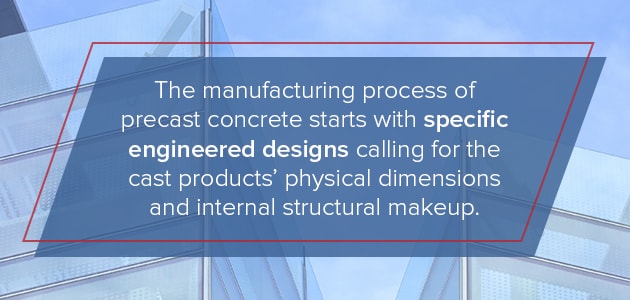
FORMING AND SETTING PRECAST CONCRETE
Precast concrete manufacturers use forms or molds to shape the finished product while the concrete cures or hardens. These forms are made from either wood or steel depending on what product is being precast. Both wood and steel have their advantages in terms of sustainability. Steel forms last a long time, but wood is reusable and is a renewable resource that can be sustainably harvested. All forms are prepared with a release agent to prevent cured concrete from bonding to the form.
Technology now allows form oil to be much more environmentally sustainable. For years, mineral oil was the mainstay. But this is a petroleum product that comes with pollution issues in addition to being an expensive, non-renewable product. Organic form release agents and synthetic oils are replacing mineral oil. Now they’re doing their part for making precast concrete products sustainable.
Reinforcement is a crucial part of the precast process. Reinforcing concrete increases its tensile strength for tension and compression, which are primary physical forces compensated for in construction design. The most common reinforcement method is recycled steel rebar and prestressing strand, which is a highly sustainable product. In fact, 71% of reinforcing steel is made from recycled materials. Other reinforcements include:
- Wire mesh
- High-tech polymer
- Fiber mesh
SUSTAINABILITY IN CONCRETE MIX DESIGN
Sustainability continues inside the concrete mix design. Concrete is mainly composed of cement and aggregates that bond through a chemical hydration process activated by water.
Producing cement is energy-intensive and is not considered sustainable. Efforts to make concrete a more sustainable material largely involve replacing cement in the concrete mix with alternatives such as leftover fly ash and slag from steel mills. However, with current capabilities, you can only replace a portion of the cement used. Waste concrete can also be crushed and recycled as aggregate.
Once precast products have cured sufficiently enough to handle, workers strip the precast piece from the mold, and the form can later be reused. Then the newly cast member is moved to a storage space where the curing process continues for up to 28 days. That’s when concrete reaches its maximum design strength.
Precast concrete products can be made in advance of their installation schedule. When needed at the site, precast pieces are trucked from factory storage and lifted right into place. This efficiency eliminates the chance of weather delays or labor shortages and contributes to the project’s economic sustainability.
HOW PRECAST CONCRETE IS SUSTAINABLE FOR THE ENVIRONMENT
Precast concrete and environmental responsibility are entirely compatible. Sustainability in concrete products comes right from the constituent materials used in making concrete. It doesn’t use scarce resources that are hard to obtain, expensive to purchase or difficult to work with.
Concrete consists of several naturally occurring ingredients. Portland cement is a blend of limestone, silica and minute amounts of several chemicals.
Concrete aggregates consist of naturally occurring gravel, sand or rock that’s crushed to a particular screen size. Aggregates lend well to recycled material like old concrete harvested from demolition sites or excess spillage from the manufacturing process. All sorts of natural mineral compounds are mined and made into aggregates. Some previously manufactured products are recycled into concrete mixes, including glass.
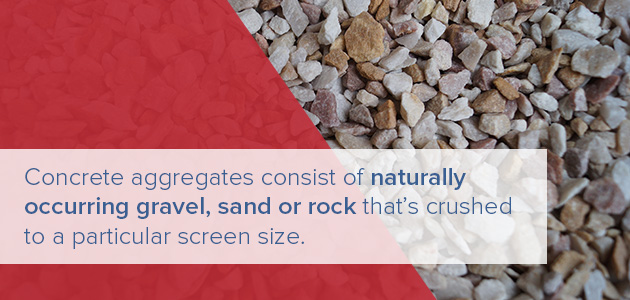
Water is the catalyst. It triggers a chemical reaction that starts the hydration or curing effect. Precast concrete can have a relatively low water-cement ratio of between 0.36 and 0.38. This low ratio means the weight of the water compared to the weight of the cement is less than in a typical mix – it also increases durability. After treating it, you can often recycle water used for making concrete.
ENVIRONMENTAL SUSTAINABILITY BENEFITS FROM PRECAST CONCRETE
There are many precast concrete sustainability benefits. On their own, each one contributes a small but important value to sustainable buildings. It’s the holistic and systematic approach that gives precast products their rightful place in helping provide long-term environmental sustainability. Consider these benefits:
- Precast manufacturing holds tighter tolerances and precise mixture proportions.
- The factory settings greatly reduce waste. That includes waste from excessive concrete, formwork and bracing, packaging and debris that accumulates on cast-in-place sites.
- Precast manufacturing businesses recycle waste material. That results in less material sent to landfills or dumped into the environment.
- Plant conditions create less dust. This is healthier for workers protected by ventilation equipment and personal protective equipment like respirators.
- Properly designed precast structural members are smaller in size and use less material than products built on-site. This means less material must be harvested from the environment and results in less to dispose of when the building’s lifecycle is over.
- The workplace environment is healthier for factory employees than those who work on construction sites. Internal shop environments have controlled conditions where air quality, noise and safety hazards are addressed.
- Most ingredients used in precast concrete are locally produced, and aggregates are mined within a short distance of production. Many precast facilities are located right at the aggregate pit or nearby. This greatly reduces hauling trips, which decreases highway traffic, fuel consumption and exhaust levels that present a risk to the public.
- Energy conservation is a huge factor in creating sustainability in buildings. Operating costs are one of sustainability’s key tenets. Precast concrete’s thermal mass absorbs and releases heat slowly. This can equate to long-term energy savings through years of cooling and heating the building, especially when combined with insulation.
- Indoor air quality is higher in buildings made with precast concrete components. Many architects specify precast pieces to serve for interior finishes, as well as exterior exposure. Exposed interior concrete surfaces have no volatile organic compounds (VOCs) that offgas toxic chemicals.
- Concrete finishes inside buildings have an attractive aesthetic appearance and reduce costs by eliminating other types of finishes.
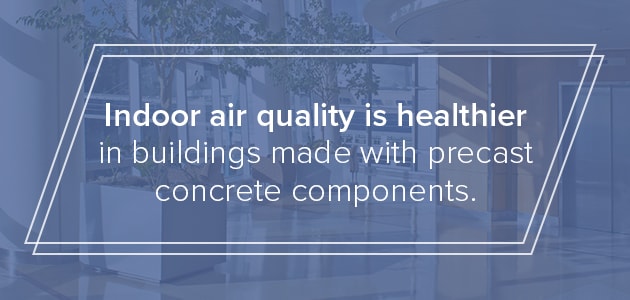
Precast concrete is truly a sustainable green product, is also highly durable and uses an extremely low water-cement ratio. All of these sustainable benefits result in precast concrete products being chosen as priority materials in LEED-certified buildings
WHAT IS LEED CERTIFICATION AND HOW DOES PRECAST CONCRETE CONTRIBUTE?
LEED is a green building rating system. It stands for Leadership in Energy and Environmental Design and is the leading authority when it comes to recognizing excellence in environmentally friendly, sustainable building design and construction. Having a building LEED-certified is a badge of honor that’s well-earned. It’s also the sustainably proper thing to do.
The United States Green Building Council (USGBC) developed the LEED green building rating system to help market the construction industry as more efficient, stable and environmentally sound. LEED is a voluntary program, not a compliance or regulatory requirement. In two decades, LEED projects have become the norm, not the exception, for industrial, commercial and residential projects.
Products used in LEED projects are consensus-based building systems. There are standards for certification and flexible design guidelines for using sustainable building products and techniques as well as ensuring long-term operation is economically and environmentally sustainable. LEED is as much of a mindset movement as it is a practical application.
LEED CATEGORIES AND POINTS
LEED ratings award points according to documented and proven achievement of LEED prerequisites. The higher the number of points a project achieves, the higher the recognition. Levels include Certified, Silver, Gold and Platinum. LEED buildings have six different categories where they can score excellence points:
- Location and Transport: Precast concrete reaches the construction site ready for installation, reducing the amount of land needed for construction activities and storage. This smaller footprint also allows projects for more flexibility in choosing a sustainable site.
- Sustainable Sites: This credit involves the conservation and restoration of natural areas. Precast concrete is ideal for building parking garages, which minimize the amount of land needed for parking. Developers can use precast to support vegetated roofs and filtration planters, which remove pollutants from water and reduce runoff.
- Water Efficiency: Precast concrete has a low water-cement ratio, and process water can be recycled and reused after treatment.
- Atmosphere and Energy: In many climates, precast components’ thermal mass enables buildings to consume less energy by reducing the need for heating and cooling. This slow absorption and release of heat, especially when combined with insulation, helps to avoid the emissions associated with the electricity generation of burning of natural gas required to heat and cool a building.
- Resources and Materials: Precast concrete often contains recycled materials, such as fly ash and slag. It can also be crushed and used as aggregate if the building is taken down or renovated. Precast concrete is also very long-lasting and durable, which minimizes the impact caused by replacement and repair.
- Indoor Environment Quality: Precast concrete does not emit VOCs, and exposed precast does not require the application of any additional material to the interior. It also offers excellent noise control and can allow sunlight to enter a building.
Many sustainable building developers use precast concrete for LEED certification. That’s because precast concrete meets or exceeds LEED specifications for environmental responsibility and long-term sustainability. That is a difficult challenge to achieve with cast-in-place concrete.
Precast concrete is truly a sustainable green product, is also highly durable and uses an extremely low water-cement ratio. All of these sustainable benefits result in precast concrete products being chosen as priority materials in LEED-certified buildings.
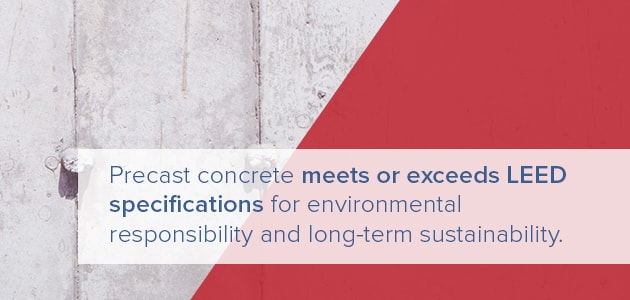
CONTACT NITTERHOUSE CONCRETE FOR SUSTAINABLE PRECAST CONCRETE PRODUCTS
Nitterhouse Concrete has been manufacturing precast concrete products for over 90 years. We supply the mid-Atlantic region with exceptional precast concrete structural products, including many that meet LEED requirements. Nitterhouse precast concrete products are environmentally sound, strong and durable. That’s what makes them entirely sustainable.
Explore the projects Nitterhouse Concrete has supplied precast concrete products to. We’re proud to showcase them for our future clients. Many of these are LEED-certified projects, which is exactly what they are designed to support.
We’re also proud of our team. Nitterhouse Concrete employs experienced craftspeople dedicated to developing and manufacturing the best and most sustainable concrete products available in the world. For more information on how we can help you and the environment, call Nitterhouse today at 717 267-4505 or contact us online.
Contact Nitterhouse Concrete Today


